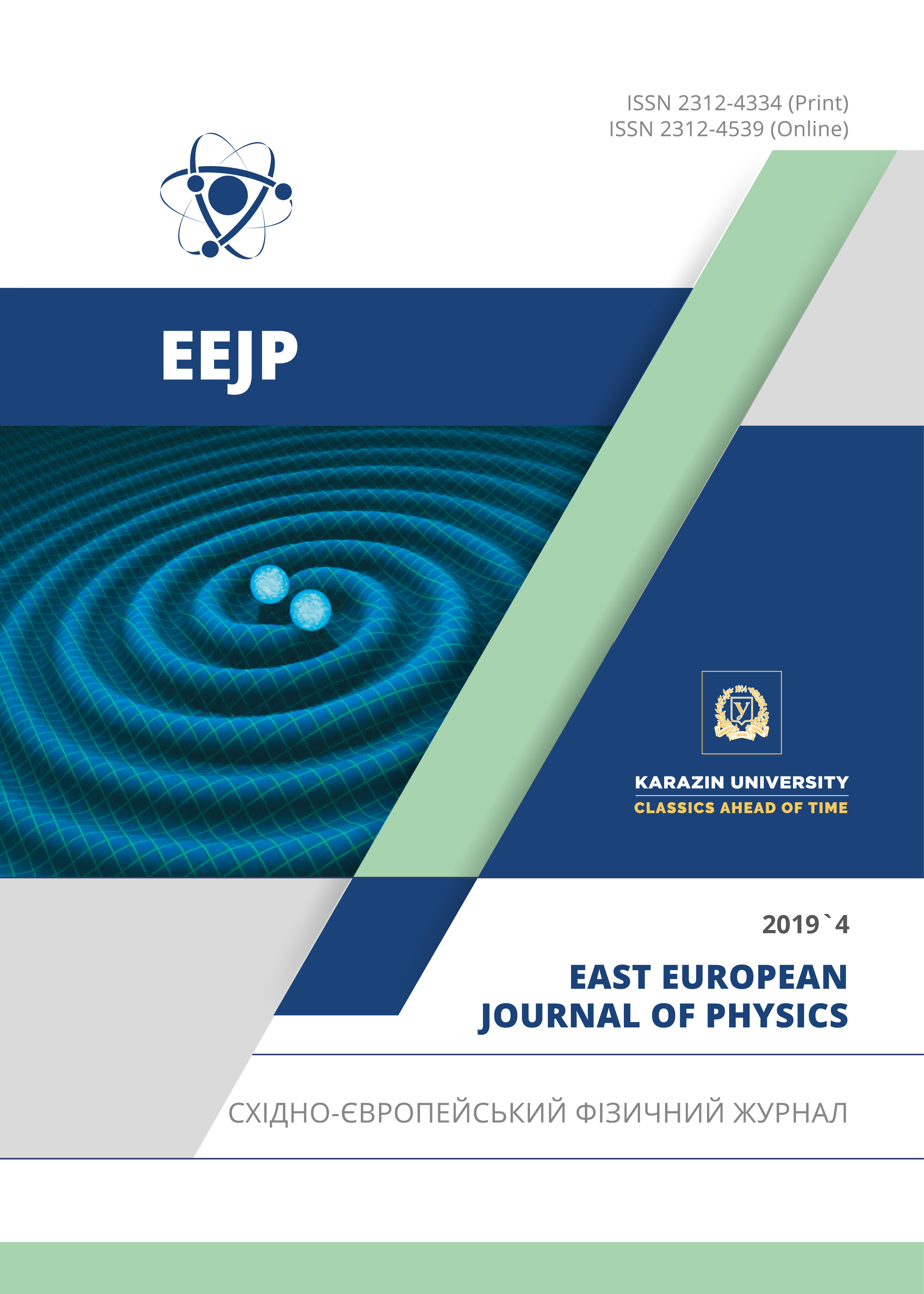The Threshold of Detection of Fission Materials by ZnWO4 and Bi4Ge3O12 Scintillation Detectors
Abstract
In the present work we found the maximum discovery distance for 239Pu-Be source using the detectors based on ZWO (ZnWO4) and BGO (Bi4Ge3O12) oxide scintillators. Detection distance was defined by using the radiation monitoring system ”PORTAL”. This research gives us data for estimation of the contribution of low-energy cascade gamma quanta CGQ. The CGQ emitted by excited scintillator nuclei defined the effective discovery distance of the fast neutrons source. The maximum detection distance was obtained with PMT in a single-photon counting mode. The maximum discovery distance for a BGO scintillator of size Ø40×40 mm – 38 cm, ZWO scintillator of size Ø52×40 mm – 54 cm, with reliability about 0.001. The results of the experiment on the ZWO scintillator can be explained by the registration of additional gamma quanta from the inelastic scattering reaction and the CGQ arising from resonant neutron capture region. This two mechanisms further lead to increase the sensitivity of the detector and increase the detection distance of the monitoring system. The key features of the monitoring system are: ZWO oxide scintillator, wide band measuring path, utilize PMT in single photon mode. The obtained detection distance was about 1.4 times higher in comparison with the spectrometric recording mode and 1.9 times higher in values of efficiency. Our results demonstrate the advantages of the ZWO scintillator compared to the BGO and demonstrate the possibility of using the resonant capture mechanism by ZWO detector nuclei to increase the fast neutrons sensitivity. The resonance capture mechanism increase sensitivity and maximum detection distance of the monitoring system. The low-energy gamma-quanta, which discharge of compound nuclei, are substantially suppressed in comparison with the classic spectrometric recording mode.
Downloads
References
M. Anellia, G. Battistoni, S. Bertolucci, C. Bini, P. Branchini, C. Curceanu, G. De Zorzi et al., Nucl. Inst. Meth. Phys. Res. A, 580, 368-372 (2007), https://doi.org/10.1016/j.nima.2007.08.005.
L.L. Nagornaya, V.D. Ryzhikov, B.V. Grinyov, L.A. Piven’, G.M. Onyshchenko and E.K. Lysetska, in: Abstracts IEEE Nuclear Science Symposium, (Drezden, Germany, 2008), pp. 714-719. https://doi.org/10.1109/NSSMIC.2008.4775229.
B. Grynyov, V. Ryzhikov, L. Nagornaya, G. Onishcenko, L. Piven’. US Patent No. 8058624 (15 November 2011), http://patft.uspto.gov/netacgi/nph-Parser?Sect1=PTO2&Sect2=HITOFF&p=1&u=%2Fnetahtml%2FPTO%2Fsearch-adv.htm&r=1&f=G&l=50&d=PTXT&S1=(%228058624%22.PN.)&OS=PN/.
V.D. Ryzhikov, B.V. Grinyov, G.M. Onyshchenko, L.A. Piven, O.K. Lysetska, O.D. Opolonin, S.A. Kostioukevitch and C.F. Smith, in: XVI SPIE Optical Engineering Proceedings, “Hard X-Ray, Gamma-Ray, and Neutron Detector Physics”, (IEEE, San Diego, 2014), https://doi.org/110.1117/12.2058185.
V.D. Ryzhikov, S.V. Naydenov, G.M. Onyshchenko, L.A. Piven, T. Pochet and C.F. Smith, Nucl. Inst. Meth. Phys. Res. A, 903, 287–296 (2018), https://doi.org/10.1016/j.nima.2018.06.074.
V. Ryzhikov, G. Onyshchenko, I. Yakymenko, S. Naydenov, A. Opolonin and S. Makhota, East Eur. J. Phys. 2, 11-18 (2019), https://doi.org/10.26565/2312-4334-2019-2-02.
G. Onyshchenko, V. Ryzhikov, I. Yakymenko, V. Khodusov, S. Naydenov, A. Opolonin and S. Makhota, East Eur. J. Phys. 3, 54-62 (2019), https://doi.org/10.26565/2312-4334-2019-3-07.
O. Kazachkovskij, Atomic Energy, 83(1), 509-515 (1997), https://doi.org/10.1007/BF02418976.
A. Voronov, S. Naydenov, I. Pritula, G. Onyshchenko, A. Shchus’ and I. Yakymenko, East Eur. J. Phys. 5(3), 45-52 (2018). https://doi.org/10.26565/2312-4334-2018-3-05.
V.D. Ryzhikov, G.M. Onishenko, I.I. Yakymenko, S.V. Najdenov, A.D. Opolonin and S.V. Mahota. XVII конференция по физике высоких энергий и ядерной физике [XVII Conference on High Energy Physics and Nuclear Physics], (NSC “KIPT”, Kharkiv, 2019), pp. 96, https://www.kipt.kharkov.ua/conferences/ihepnp/2019/collection_of_theses_%D0%A5VII_hepnp.pdf. (in Russian)
Citations
Counting Efficiency and Neutron/Gamma Ratio for KDP: Tl+ and UPS-923A Scintillators in a Single Photone Detection Mode
(2020) East European Journal of Physics
Crossref
Copyright (c) 2019 Gennadiy M. Onyshchenko, Volodymyr D. Ryzhikov, Ivan I. Yakymenko, Oleksandr P. Shchus’

This work is licensed under a Creative Commons Attribution 4.0 International License.
Authors who publish with this journal agree to the following terms:
- Authors retain copyright and grant the journal right of first publication with the work simultaneously licensed under a Creative Commons Attribution License that allows others to share the work with an acknowledgment of the work's authorship and initial publication in this journal.
- Authors are able to enter into separate, additional contractual arrangements for the non-exclusive distribution of the journal's published version of the work (e.g., post it to an institutional repository or publish it in a book), with an acknowledgment of its initial publication in this journal.
- Authors are permitted and encouraged to post their work online (e.g., in institutional repositories or on their website) prior to and during the submission process, as it can lead to productive exchanges, as well as earlier and greater citation of published work (See The Effect of Open Access).








